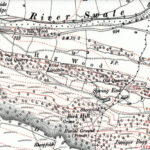16 November 1771: Rescue boats are brought overland from Stockton to Yarm, flooded by ice melt and heavy rain from Teesdale
Henry Heavisides. 1865. The Annals of Stockton-on-Tees. Stockton-on-Tees: H. Heavisides and Son. Get it:
.Excerpt
When the great flood took place in the Tees, Yarm was almost completely sunk under water. I spent two or three hours lately there with an intelligent merchant, Mr Dod, an old inhabitant of the town, who, after showing me, in the most obliging manner, his commodious, well-stocked warehouses, pointed out the height which this tremendous flood had risen by a mark cut across one of his granary doors when it occurred, and cut, no doubt, in commemoration of it. The granary is a tall building, two storeys high, and the cut is nearly at the top of a door in the second storey, which is ascended outside by a long flight of stone steps. On looking at this cut some idea may be formed of the immense height which the waters rose at this flood. They were so high indeed, that “many houses,” says the Annual Register of 1771, “were covered almost to the rafters, and many inhabitants taken from them in boats. Much assistance was afforded by the inhabitants of Stockton to their distressed neighbours. Carts with bread and other provisions were sent speedily to them, and great bodily exertions were made by several gentlemen to rescue them from their alarming situation.” The river Tees swelled to such a degree on that occasion as to rise twenty feet perpendicular higher than the oldest man then living could remember. It was long remembered by the name of “THE FLOOD.” A work, published in 1818, entitled “An account of the great floods in the rivers Tyne, Tees, etc. by W.G.,” states, that “on Saturday night, Nov. 16th, 1771, there was the greatest flood in the river Tees that was ever known in the memory of man. The flood at Stockton, though greater than ever remembered, did not do much damage; one warehouse and two or three cellars with liquor were under water. As soon as the flood was discovered at Stockton, carriages were procured to take boats over land to Yarm, with some experienced sailors, who thereby saved the lives of many.”
Comment
Comment
Heavisides says that Yarm was already in decline vis-à-vis Stockton:
Another work, entitled “A particular description of the Bishoprick or county Palatine of Durham, by Nat. Sanderson,” published in 1767, says, that “Stockton has risen upon the ruins of the trade of Yarum, and from a little dirty town near the mouth of the Tees, with a few thatched clay houses, it is become a neat well-built market town, driving a considerable trade in lead, butter, cheese, bacon, corn, and ALE, which, says another account in 1762, is “remarkable for its beautiful colour and fine flavour, and much better known in London than it is at present.”
Bishop Richard Pococke in 1760 on Yarm (and Stockton):
I went four miles to Yarum (by a turnpike road) situated on the Tees in Yorkshire, over which river there is a bridge here of five arches. The river forms a peninsula, and small vessels come up to the town ; which consists of a very handsome street, a small town house and some lanes which go from the streets. They have & handsome church of stone almost new built. There is a great market and large store houses, the merchants of Stockton buying up goods here which are brought even from Cumberland. Near the church is a field called Road-hill, where there are some old foundations, and they have a notion that here was a monastery. This might be the hospital of St. Nicholas founded by one of the Bruse family in 1185 and granted afterward by Alan de Wilton to the canons of Helagh Park.
At the west end of the town Mr. Farmer has a house and pleasant walks from it on the hanging ground over the river. This is called the Frerie and here also they suppose there was a, convent. And without doubt it was the house of the Black Friars founded by Peter de Brus the II. who died in 1271.
(Pococke 1915)
Something to say? Get in touch
Original
When the great flood took place in the Tees, Yarm was almost completely sunk under water. I spent two or three hours lately there with an intelligent merchant, Mr. Dod, an old inhabitant of the town, who, after showing me, in the most obliging manner, his commodious, well-stocked warehouses, pointed out the height which this tremendous flood had risen by a mark cut across one of his granary doors when it occurred, and cut, no doubt, in commemoration of it. The granary is a tall building, two storeys high, and the cut is nearly at the top of a door in the second storey, which is ascended outside by a long flight of stone steps. On looking at this cut some idea may be formed of the immense height which the waters rose at this flood. They were so high indeed, that “many houses,” says the Annual Register of 1771, “were covered almost to the rafters, and many inhabitants taken from them in boats. Much assistance was afforded by the inhabitants of Stockton to their distressed neighbours. Carts with bread and other provisions were sent speedily to them, and great bodily exertions were made by several gentlemen to rescue them from their alarming situation.” The river Tees swelled to such a degree on that occasion as to rise twenty feet perpendicular higher than the oldest man then living could remember. It was long remembered by the name of “THE FLOOD.”
A work, published in 1818, entitled “An account of the great floods in the rivers Tyne, Tees, etc. by W.G.,” states, that “on Saturday night, Nov. 16th, 1771, there was the greatest flood in the river Tees that was ever known in the memory of man. The flood at Stockton, though greater than ever remembered, did not do much damage; one warehouse and two or three cellars with liquor were under water. As soon as the flood was discovered at Stockton, carriages were procured to take boats over land to Yarm, with some experienced sailors, who thereby saved the lives of many.”
344 words.
Similar
Search
Donate
Music & books
Place-People-Play: Childcare (and the Kazookestra) on the Headingley/Weetwood borders next to Meanwood Park.
Music from and about Yorkshire by Leeds's Singing Organ-Grinder.





 Bluesky
Bluesky Extwitter
Extwitter